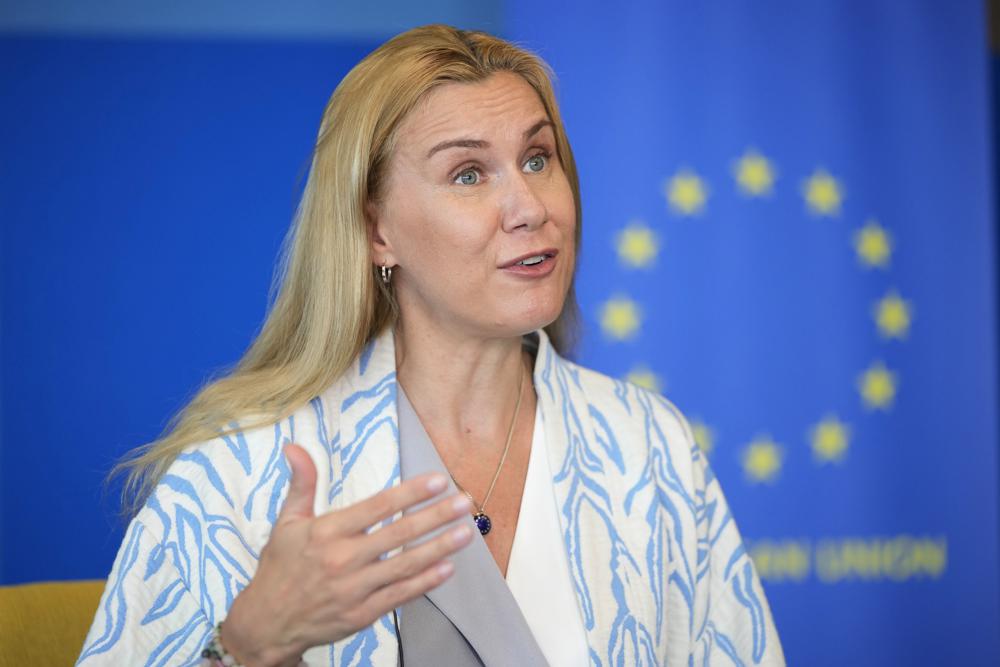The European Union’s next steps for addressing the continent’s worsening energy crisis following Russia’s invasion of Ukraine are expected to be unveiled next week, the European commissioner for energy said Tuesday.
Many European countries have tightened their belts as energy costs soar. Russia’s state-run energy company has continued its shutdown of a pipeline carrying natural gas to Europe, in what German officials see as a political power play, and the European Commission president says the EU’s electricity market “is no longer operating” amid knock-on effects from the Ukraine war.
An extraordinary meeting of the European Union’s energy ministers will be held in Brussels on Friday to discuss a bloc-wide package of solutions to the power market cost spikes, European Commissioner for Energy Kadri Simson told The Associated Press in an interview.
She said the European Commission expects the package will be adopted next Wednesday, and that a decoupling of gas and energy prices, increase in liquidity for the market and coordinated demand reduction could be expected in it. That could include a temporary capping of the price of gas used to produce electricity, modification of trading rules on energy exchanges and coordinated demand reduction measures like those seen over the summer.
“We know that there are peak hours where our households and enterprises are witnessing extreme high hourly prices,” she said in the interview at the European Delegation office in Jakarta. “Part of this proposal is also dealing with peak hours and how it will cut demand at these specific timeslots.”
European nations have worked to get creative about energy alternatives. One short-term fix is roughly 20 floating terminals that would receive liquefied natural gas from other countries and convert it into natural gas for homes and businesses.
The plan, with the first floating terminals set to start delivering gas by year’s end, has raised alarm among experts who fear the long-term consequences for the environment. They warn that the terminals would perpetuate Europe’s reliance on natural gas, which releases climate-warming methane and carbon dioxide when it’s produced, transported and burned.
“Right now, in this situation where Russia is using their natural gas supplies as a weapon, we have to take care to secure the supply. And that means that some extraordinary investments are needed,” Simson said when asked about the environmental concerns.
Simson also acknowledged that the global rising cost of gas has pushed some countries to resort to cheaper but more environmentally destructive energy sources.
“We are taking responsibility,” she said. “The biggest step that we are making to not impact the global gas and LNG market is agreeing that we will cut our gas consumption.”
The European Union has a binding commitment to cut greenhouse gas emissions by at least 55% by 2030 and to reach net zero greenhouse gas emissions by 2050. Natural gas has been promoted as a “bridge fuel” because in power plants it produces less carbon dioxide when burned than coal. But some experts are critical of the move.
“For this winter we have made — and several national governments have made — a set of commitments to reduce energy consumption,” Simson said. “We will not achieve our climate targets unless we will prioritize energy savings.”
Simson also said that the current energy crisis in Europe has made it clearer that renewable energy such as solar and wind are essential for energy in the future.
“Renewables do not only matter on the climate side, but they also allow us to take the responsibility for our consumption into our own hands,” said Simson, who came to Indonesia to attend a meeting of the Group of 20 leading rich and developing countries in Bali.
Back in Brussels, European authorities carefully weighed in on a debate between the bloc’s member states on the feasibility of constructing another, larger pipeline that could carry natural gas, and potentially in the future hydrogen as well, from Spain to France and beyond.
Germany has openly backed the MidCat/STEP plan promoted by Spain and Portugal for a pipe that would cross the Pyrenees and allow the Iberian neighbors to pump energy flowing northwards through France and eventually to countries feeling the crunch, such as Germany.
Spain and Portugal boast Europe’s largest number of liquified natural gas (LNG) plants at their ports, and Spain wants to kickstart a green hydrogen energy business. Spain’s limited connections with France, however, limit its capacity to send gas north, the Spanish government argues.
But French President Emmanuel Macron shot down the idea on Monday when he questioned the usefulness of a project that would likely need years to complete to get natural gas flowing and even more time, experts say, to be conditioned for green hydrogen. France relies heavily on nuclear energy and in theory has little to gain from more connections.
Tim McPhie, European Commission spokesman for Climate Action and Energy, said Tuesday that France would have to be on board for the project to go forward.
“Investments to connect the LNG import terminals in the Iberian Peninsula to the broader gas network through hydrogen-ready infrastructures may further contribute to diversifying gas supply in the internal market,” McPhie said, “but again it is important to underline that the project is not yet at the stage where we can make an evaluation.”
Spain’s minister in charge of energy policy, Teresa Ribera, insisted that she would bring the pipeline plan to the table on Friday with her counterparts from other EU countries.
Ribera said “it will be one of the questions that captures the interest of Europe’s leaders for a long time to come.”
(AP)






